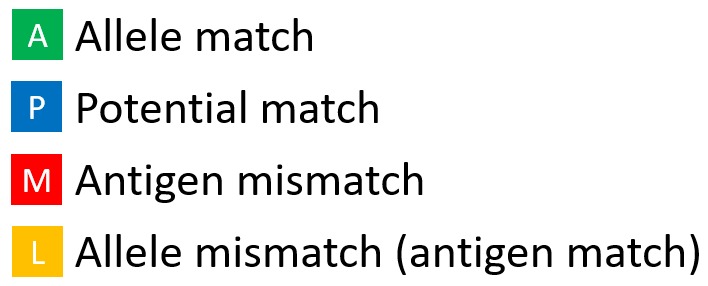On this page we will try to explain some behaviour of the match engines in our Search and Match application.
For more info on this please see the following slides.
Antigen Recognition Domain explained
- The antigen recognition domain (ARD) is the binding groove of the HLA peptide. This is the region interacting with the presented antigen and T-cell receptor.
- All alleles that express the same amino acid sequence in this region are considered an allele match.
- The ARD is encoded on:
- exon 2 & 3 for HLA class I
- exon 2 for HLA class II
1. Null allele treatment in Hap-E search
- Null alleles are treated as absent, i.e. the second typing matches as homozygous.
- Null allele matching rules are applied to:
- All high resolution null alleles.
- Null alleles as part of multi allele codes if the null allele is part of a haplotype matching the donor‘s (patient‘s) HLA typing.
- Null allele matching rules are only applied to one typing of the locus.
The following table explains situations where Hap-E performs null allele treatment and whether this is a considered a (potential) match or not.
Patient typing | Donor typing | Hap-E | ATLAS |
|---|---|---|---|
A*03:01, A*01:11N | A*03:01, A*03:01 | matches | matches |
A*03:01, A*01:11N | A*03:01, A*02:125N | matches | matches |
If there is a haplotype compatible with the donor typing containing A*02:125N then | |||
A*03:01, A*01:11N | A*03:01, A*02:GFJM | matches | matches |
A*03:01, A*03:01 | A*03:01, A*02:XX | matches | matches |
A*03:01, A*03:01 | A*03:01, A*01:01:01G | does not match | |
A*01:11N, A*02:125N | A*03:01, A*03:01 | does not match |
02:GFJM ≜ 02:01/02:105/02:125N
2. Search with two mismatches
Hap-E search | ATLAS search |
|---|---|
| The two mismatches can be on any locus. | The two mismatches can be on any locus. |
3. Donors with DNA and serologic typing
Hap-E search | ATLAS search |
|---|---|
Only the DNA typing information is used for matching. | Only the DNA typing information is used for matching. |
4.1 Match grades: Overview
Standard match grades | DPB1-specific match grades |
|---|---|
Applied to locus A, B, C, DRB1, DQB1 | Applied to DPB1 only. Uses TCE3 model. |
5. No haplotype based probability available
Algorithm behaviour if the patient / donor typing is ambiguous and has no representation in the haplotype frequency set:
Hap-E search | ATLAS search |
|---|---|
No probabilities are calculated (inexplicable donor). | No probabilities are calculated (inexplicable donor). |
6. Cord Blood search options
Hap-E search | ATLAS search |
|---|---|
Allele matched:
| Allele matched:
|
|
|
7. Probability display
Hap-E search | ATLAS search |
|---|---|
All probabilities are rounded to integer values. → 0%:
| All probabilities are rounded to integer values. → 0%:
|
8.1 Locus match probabilities: Definition
Hap-E search | ATLAS search |
|---|---|
match, i.e. 10/10, 8/8 or 6/6
mismatch, i.e. 9/10, 7/8 or 5/6
So this probability provides information on which locus the next mismatch will occur. | match, i.e. 10/10, 8/8 or 6/6
mismatch, i.e. 9/10, 7/8 or 5/6
So this probability provides information on the probability that this locus will be a match.. |
8.2 Locus match probabilities in Hap-E search: Not displayed
In some cases the value is not defined and no locus match probability is displayed:
Hap-E search | ATLAS search |
|---|---|
match
mismatch
inexplicable donors
| match
mismatch
|





